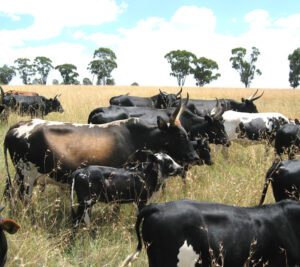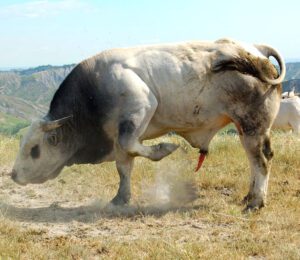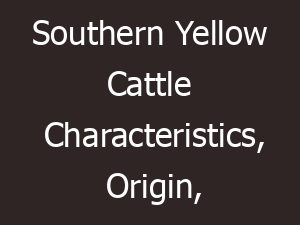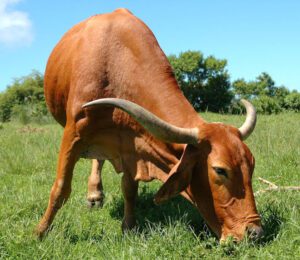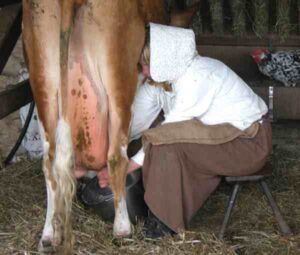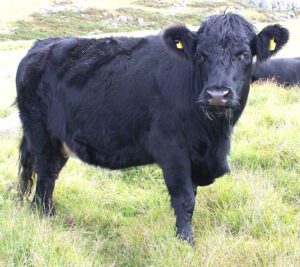The Gelbvieh cattle are a multipurpose breed of cattle which are raised for milk, meat and also for draught purposes. But the modern animals are mainly used for meat production.
They originated in the three Franconian districts of Northern Bavaria in southern Germany in the mid-18th century. They were originally known as ‘red-yellow Franconian cattle‘, and also called Einfarbig gelbes Hohenvich, German Yellow.
The breed was developed from several local cattle breeds. Those local breeds began to be combined into what would eventually be the Gelbvieh, and the new breed was officially formed by 1920.
The Gelbvieh cattle have been introduced and available in several countries around the world. Australia, Canada, Great Britain, Portugal, Spain, South Africa and United States are some countries where the breed has been introduced mainly through the use of artificial insemination and also some live export.
In 1972 the first Gelbvieh genetics reached Canada from Germany. Currently it is the 6th largest meat cattle breed in Canada with 3500 animals registered yearly.
Leness Hall first imported the breed from Germany to the United States in 1971. And the American Gelbvieh Association was formed in 1971, and currently there are over 45,000 registered Gelbvieh cows in the United States.
The first American National Gelbvieh Show was held in January 1977 in conjunction with the National Western Stock Show in Denver, Colorado. Read more information about the breed below.
Gelbvieh Cattle Characteristics
The Gelbvieh cattle are medium to large sized animals with a long body and with above average muscling. The breed was originally horned, but now the majority of the animals are polled or hornless.
They are mainly red in color with strong skin pigmentation, and also are of reddish gold to russet or black in color. They have fine hair which make them ideal for the temperate to arid conditions.
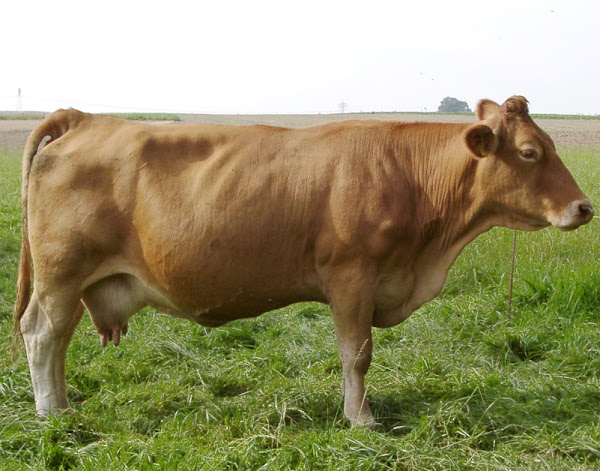
The bulls are beautiful and have above average muscling. And the cows have well-developed udders. Average live body wight of the mature bulls is around 1000 kg. And the mature cows weight around or up to 600 kg. Photo and info from Wikipedia.
Uses
Gelbvieh cattle are multipurpose animals. They are good and used for both milk and meat production. And the breed is also very good for draught purposes.
Special Notes
The Gelbvieh cattle are hardy animals and they are known for their high rate of weight gain and feed efficiency. They are also well known for their easy growth, length of loin, quick maturity, leanness, longevity and docile temperament.
They are well adapted to native climates and also able to adapt many different rangelands and climate conditions. The Gelbvieh cows were selected to be very maternal with strong fertility, good udders, mothering instincts and high milk production.
They are also known for easy of calving as they known to have smaller bodied offspring. Meat of the Gelbvieh cattle breed is lean and they grow relatively faster.
They produce high quality tender meat. They can produce Champion carcases when crossed with British cattle breeds.
The breed is also very good for milk production. They were previously used for mainly milk production. They have exceptional udders and have great milking ability.
Gelbvieh cattle are noted for their tolerance to both heat and cold temperatures, and are well-adapted to almost all climates throughout the world. Review full breed profile of the Gelbvieh cattle in the chart below.
| Breed Name | Gelbvieh | |
| Other Name | Einfarbig gelbes Hohenvich, German Yellow | |
| Breed Purpose | Milk, meat and draught | |
| Special Notes | Very hardy, active, well adapted to almost all climates, very good milkers, grow relatively faster, good quality meat, longevity, easy calving, length of loin, docile temperament | |
| Breed Size | Medium to Large | |
| Bulls | Around 1000 kg | |
| Cows | Around 600 kg | |
| Climate Tolerance | Almost all climates | |
| Coat Color | Mainly red, and also are of reddish gold to russet or black in color | |
| Horned | Yes, also polled version available | |
| Milk Yield | Very good | |
| Rarity | Common | |
| Country/Place of Origin | Germany |

